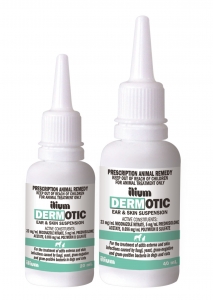Managing ear infections in dogs
Frequently Asked Questions
What is otitis externa?
Otitis externa (OE) is inflammation of the external ear canal (‘ot’ = ear, ‘itis’ = inflammation, ‘externa’ = external). It is frequently associated with head shaking, scratching at affected ear(s), pain, swelling, redness, discharge, a bad odour and a head tilt. Ear infections can occur in one or both ears depending on the underlying cause of the infection.
Why has my dog developed otitis externa?
The external ear canal, like the rest of the skin on your dog’s body has a natural population of many bacterial species, yeast and fungi living in a delicate balance. Disruption to the ear canal can lead to overgrowth of one or more of these organisms resulting in infection. OE can develop for multiple reasons. Foreign bodies such as grass seeds, that get lodged in the external ear canal can cause inflammation and secondary infection. Underlying allergies, whether it be environmental in origin e.g. pollen allergies, or to food e.g. certain carbohydrates or proteins, can cause generalised inflammation of the skin and external ear canal which predisposes the dog to ear infections. Dogs that love to swim and have pendulous ears, e.g. spaniels are more prone to ear infections. Water that enters the external ear canal gets trapped by the pendulous ear flap. A warm and wet environment develops, favouring microbial growth leading to infection. Dogs that naturally have narrower ear canals also tend to get ear infections more frequently as the air flow in the canal is reduced, again creating an environment that favours microbial growth.
What organisms are responsible for ear infections?
Ear infections in dogs are most commonly due to an overgrowth of either bacteria or yeast, or a combination of the two. Your vet may swab the ear to determine what is causing the infection and then determine the best medication for your dog. Ear swabs may be sent to a laboratory to grow up the organisms that are causing the issue in the ear and determine their likely response to certain medications.
My vet has prescribed Dermotic for my dog, how does Dermotic work?
Dermotic contains a combination of active ingredients that work against bacteria, yeast, fungi as well as provides anti-inflammatory pain relief. Dermotic is applied into the affected ear(s) to have a direct effect at the site of infection. By reducing inflammation in the ear quickly, your dog will feel a lot more comfortable and makes applying ear drops easier.

How do I apply Dermotic ear drops?
Applying any amount of liquid to a dog’s ear is likely to encourage it to shake his/her head. You may find it beneficial to treat your dog in a contained outside environment. Gently restrain your dog, lift the ear flap and dispense the volume of Dermotic prescribed by your vet into the affected ear canal. Gently massage the base of the ear. You will likely hear a ‘squelching’ noise. Massaging the base of the ear will help distribute the medication throughout the external ear canal. You may find your dog likes the feeling and leans into you and may stamp his/her back feet while you are doing it. Wipe away any discharge at the ear canal opening with some cotton wool. Never insert anything, such as a cotton bud, into the ear canal, this could cause serious damage to the structures deeper in the ear.
My vet has also prescribed an ear cleaner, what is the best way to use both products?
Ear cleaners are used in addition to medicated ear drops to remove as much discharge and debris from the ear as possible. Removing this debris allows better contact of the medicated ear drops with the skin of the ear canal. Ear cleaners should be used BEFORE applying medicated ear drops. You want the medicated ear drops to remain in the ear to have their effect and not be washed out by the cleaner. Your vet may recommend periodic cleaning of your dog’s ears beyond the initial course of treatment if he/she is prone to ear infections. Always follow your vet’s recommendations on whether this is appropriate and the frequency at which it should be done.

My dog seems happier having started Dermotic, should I stop giving the medication?
It is important to follow the dosing instruction given to you by your vet – not only in terms of volume of Dermotic to apply but also the duration of treatment. Depending on the severity of the ear infection, some dogs will respond very quickly to treatment. It is however important not to stop applying medication too early as the infection needs to be cleared completely to prevent it flaring up again immediately. Attend all follow up appointments recommended by your vet to ensure the ear is healing well.
My dog gets recurrent ear infections, what can I do to help reduce their occurrence?
Some dogs are more prone to ear infections than others. The underlying cause of the infection is likely to determine whether it will be a recurring issue. Grass seed penetration for example is likely to be a one-off issue. However, if your dog regularly runs through paddocks of long grass, the frequency at which this can occur will be increased. If your dog has been diagnosed with atopic dermatitis, the risk of recurrent ear infections is higher. Your vet will work with you to manage the condition, which can affect multiple parts of the body at the same time and tends to be a chronic condition that is managed, rather than cured.

